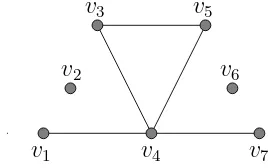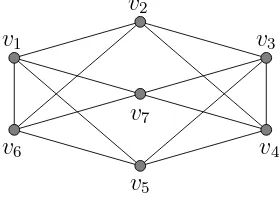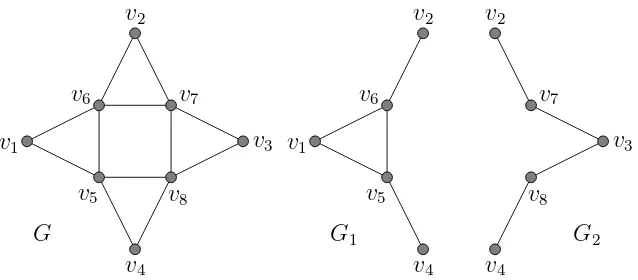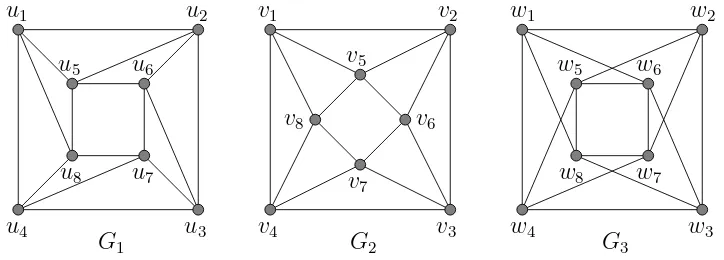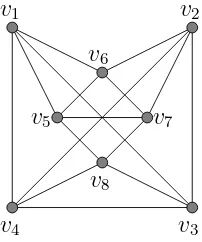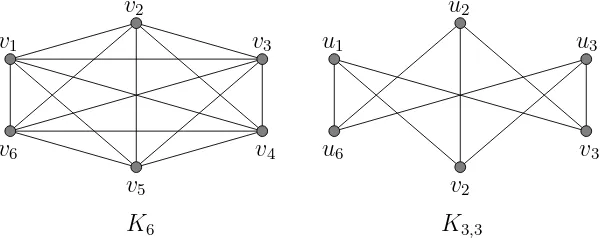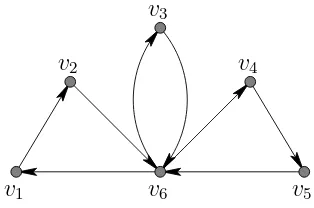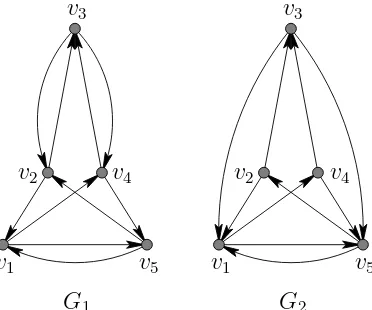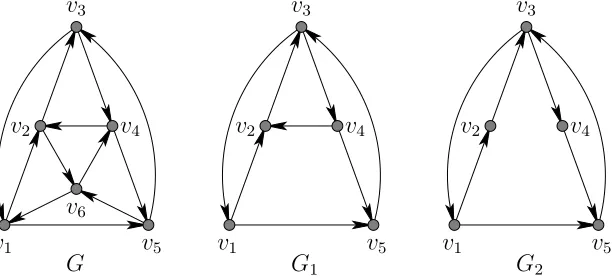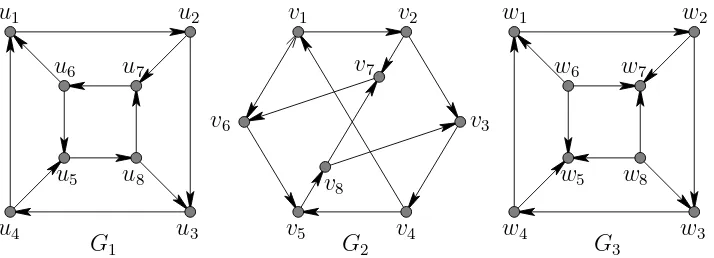Basic Concepts in Graph Theory
1
Undirected graphs
A graph G is defined to be a pair of sets (V(G), E(G)), where V(G) is a finite nonempty set of elements called vertices, and E(G) is a set (possibly empty) of unordered pairs {u, v} of vertices u, v ∈V(G) called edges. V(G) is called thevertex-set ofGand E(G) is called theedge-setof G. A graphG
may contain loops, that is, edges of the form {u, u}, and/or multiple edges, that is, edges which occur more than once. For brevity, an edge {u, v} is often denoted by uv. The order of a graph G is the number of vertices in G. Figure 1 shows an example of a graph of order 7 with vertex-set
{v1, v2, v3, v4, v5, v6, v7} and edge-set {v1v4, v4v3, v3v5, v5v4, v4v7}.
Letuandv be vertices of a graphG. We say thatuisadjacenttovif there is an edge ebetween u andv, that is, e=uv. Then we callv aneighbour of u. The set of all neighbours ofu is called theneighbourhood ofu and is denoted by N(v). We also say that both vertices u and v are incident with edge e. For example, in Figure 1, vertex v1 is adjacent to vertex v4; and vertex v3 is incident with edges v3v4 and v3v5.
v7
v4
v1
v2 v6
v5
v3
Figure 1: Example of a graph
The degreeof a vertexv of Gis the number of vertices adjacent tov, that is, the number of all neighbours of v. If a vertex v has degree 0, which means that v is not adjacent to any other vertex, thenv is called anisolated vertex, or isolate. A vertex of degree 1 is called an end vertex, or a leaf. In Figure 1, the degree of v4 is 4, v2 is an isolated vertex, and v1 is an end vertex. If
For example, the graph in Figure 2 is regular of degree 4.
v7
v1 v3
v2
v4 v5
v6
Figure 2: Example of a regular graph
Av0−vlwalkof a graphGis a finite alternating sequencev0, e1, v1, e2, ..., el, vl
of vertices and edges in Gsuch that ei =vi−1vi for each i, 1 ≤i≤l. Such a
walk may also be denoted by v0v1...vl. We note that there may be repetition
of vertices and edges in a walk. Thelengthof a walk is the number of edges in the walk. Av0−vlwalk isclosedifv0 =vl. If all the vertices of av0−vl walk
are distinct, then the walk is called apath. Acycleis a closed path. In Figure 2, v1v2v6v7v4v2v3 is a walk of length 6 which is not a path, v1v2v3v4v5v6 is a path of length 5, and v1v7v3v5v1 is a cycle.
The distance from vertex u to v, denoted by δ(u, v), is the length of the shortest path from vertex u to vertex v. For example, the distance from vertex v1 to v4 of the graph in Figure 2 is 2. The diameter of a graph G is the longest distance between any two vertices in G. The girth of a graph G
is the length of the shortest cycle in G. For example, the graph in Figure 2 has diameter 2 and girth 3.
A graphH is asubgraph ofGif every vertex ofH is a vertex ofG, and every edge ofHis an edge ofG. In other words,V(H)⊂V(G) andE(H)⊂E(G). Let U be a subset of V(G). The induced subgraph G[U] is a subgraph of G
consisting of the vertex-set U together with all the edges uv of G where
u, v ∈U. In Figure 3,G1 is an induced subgraph ofG, andG2 is a subgraph of G but not an induced subgraph (because in G2, v7, v8 ∈ V(G) but there
is no edge between v7 and v8 while u7u8 ∈E(G)).
v1
Figure 3: Graph and two of its subgraphs
Thus a disconnected graph contains at least two components. For example, the graph in Figure 2 is connected, but the graph in Figure 1 is disconnected (because there is no path between v2 and any other vertex).
Let e be an edge of a graph G. Then G− {e} is a graph obtained from G
by deleting the edge e from G. If G− {e} is disconnected, then e is called a bridge. In general, if E1 is any set of edges in G then G−E1 is a graph obtained fromG by deleting all edges inE1. Furthermore, E1 is called a cut set if G−E1 is disconnected.
Similarly, if v is a vertex of a graph G, then G− {v} is a graph obtained from Gby deleting the vertex v and all edges incident with v. If G− {v} is disconnected, then v is called a cut-vertex. A graph G is said to be a non-separable graphif it does not contain a cut-vertex. LetV1 be a set of vertices
inG. Then G−V1 is a graph obtained fromG by deleting all vertices in V1
and all edges incident with the vertices in V1. V1 is called a separating set if
G−V1 is disconnected. These ideas are illustrated in Figure 4.
Two graphs G1 and G2 with n vertices are said to be isomorphic if there exists a one-to-one mapping f : V(G1) → V(G2) which preserves all the
adjacencies, that is, f(u) and f(v) in G2 are adjacent if and only if u and
v in G1 are adjacent. In Figure 5, graphs G1 and G2 are isomorphic under the mapping f(ui) =vi, for everyi= 1,2, ...,8. However, graphsG1 and G3
v1
Figure 4: Obtaining new graphs by deleting an edge or a vertex
adjacencies. which preserves all the adjacencies, that is,f(u) andf(v) are adjacent if and only if u and v are. For example, consider the graph G2 in Figure 5 under the mapping f defined by f(v1) = v3, f(v2) = v4, f(v3) = v1, f(v4) = v2,
f(v5) =v7, f(v6) = v8, f(v7) = v5, f(v8) = v6. Then f is an automorphism
of the graph G2.
A graph G is vertex-symmetric (also known as vertex-transitive) if for any two vertices x and y of G, there exists an automorphism of G that carries
namely,v1, v5, v6;v2, v6, v7; andv5, v6, v7, while vertex v8 lies in two cycles of length three, namely, v3, v4, v8 and v5, v7, v8. Thus in this case there cannot
be any automorphism that carries vertex v6 to vertexv8.
v1 v2
v3 v4
v5 v6
v7
v8
Figure 6: Example of non-vertex-symmetric graph
Acomplete graphonnvertices, denotedKn, is a graph in which every vertex
is adjacent to every other vertex. Thus Kn has (n2) =
n(n−1)
2 edges. A graph
G is bipartite if V(G) can be partitioned into two subsets V1 and V2, called
partite sets, such that there are no edges between any vertces withinV1 and
between any vertices within V2. If G contains all edges joining each vertex in V1 to each vertex in V2, then Gis called a complete bipartite graph. Such
a graph is denoted by Km,n, where m = |V1| and n = |V2|. More generally,
acomplete n-partite graphis a graph whosen partite setsV1, V2, . . . , Vn such
that two vertices are adjacent if and only if they lie in different partite sets. If
|Vi|=pi, then this graph is denoted byKp1,p2,...,pn. Figure 7 shows examples
of the complete graph K6 and the complete bipartite graph K3,3.
The adjacency matrix of a graph G and vertex-set V(G) = {v1, v2, ..., vn} is the n×n matrix A= [aij], where
aij =
(
1 if vivj ∈E(G),
0 otherwise.
v1 v3 v2
v4 v5
v6
u1 u3
u2
v3 v2
u6
K6 K3,3
Figure 7: Complete graphK6 and complete bipartite graph K3,3
A=
0 1 0 0 1 1 0 1 1 0 0 1 0 1 0 0 1 1 0 1 1 0 0 1 0
v1 v5
v3
v2 v4
2
Directed graphs
A directed graph or a digraph G is a pair of sets (V(G), A(G)) where V(G) is a finite nonempty set of distinct elements called vertices, and A(G) is a set of ordered pair (u, v) of distinct vertices u, v ∈ V(G) called arcs.
V(G) is called the vertex-set of G and A(G) is called the arc-set of G. Again for brevity, an arc (u, v) is often denoted by uv. The number of vertices in G is called the order of the digraph G. Figure 9 shows an exam-ple of a digraph of order 6 with vertex-set {v1, v2, v3, v4, v5, v6} and arc-set
{v1v2, v2v6, v6v3, v3v6, v6v4, v4v5, v5v6, v6v1}.
v1
v2
v3
v4
v5
v6
Figure 9: Example of a digraph
Anin-neighbour(respectively, out-neighbour) of a vertexv inGis a vertex u
(respectively, w) such that (u, v)∈A(G) (respectively, (v, w)∈A(G)). The set of all in-neighbours (respectively, out-neighbours) of a vertex v is called the in-neighbourhood (respectively, the out-neighbourhood) of v and denoted byN−(v) (respectively, N+(v)). The in-degree (respectively,out-degree) of a
vertexv is the number of all its in-neighbours (respectively, out-neighbours). If every vertex of a digraph G has the same in-degree (respectively, out-degree) thenGis said to bein-regular(respectively,out-regular). If a digraph
Gis in-regular of in-degreedand out-regular of out-degreed, thenGis called a diregular digraph of degree d. For example, the digraph G1 in Figure 10
is diregular of degree 2, but the digraph G2 is not diregular (since G2 is out-regular but not in-regular).
Awalk of lengthl in a digraphGis an alternating sequencev0a1v1a2...alvl of
vertices and arcs inGsuch thatai = (vi−1, vi) for eachi, 1≤i≤l. A walk is
v2
v5
v1 v1 v5
v3
v3
v4
v2 v4
G1 G2
Figure 10: Diregular digraph and non-diregular digraph
walk is called a path. Acycle is a closed path. A digon is the cycle of length 2. We assume that walk, path and cycle in a digraph are all directed. In Figure 9,v1v2v6v3v6v4v5 is a walk of length 6 which is not a path;v1v2v6v4v5
is a path of length 4;v1v2v6v1 is a cycle of length 3; and v3v6v3 is a digon.
The distance from vertex u to vertex v, denoted by δ(u, v), is the length of the shortest path from u to v, if any; otherwise δ(u, v) = ∞. Note that in generalδ(u, v) is not necessarily equal toδ(v, u). The diameter of a digraph
G is the longest distance between any two vertices in G. For example, both digraphs in Figure 10 have diameter 2, while the digraph in Figure 9 has diameter 4. The girth of a digraph G is the shortest length of the cycles in
G. For example, the girth of the digraph in Figure 9 is 2.
From now on, we denote byG(n, d, k) the set of all digraphsG, not necessarily diregular, of order n, maximum out-degree d, and diameter k.
We say that a vertexv isreachablefrom a vertex u in a digraphGif there is a directed path from u to v. A digraph G is called strongly connected if for any two distinct vertices of G, each vertex is reachable from the other. For example, the digraphG1 in Figure 11 is strongly connected, but the digraph
G2 in Figure 11 is not strongly connected because v1 is not reachable from other vertices.
v6
Figure 11: Strongly connected digraph and non-strongly connected digraph
every arc of H is an arc of G. Let U be a subset of V(G). The induced subdigraphG[U] is a subdigraph ofG consisting of the vertex-setU together with all the arcs uv of G where u, v ∈ U. In Figure 12, G1 is an induced subdigraph ofG, andG2is a subdigraph ofGbut not an induced subdigraph
(because there is no arc between v4 and v2).
Figure 12: Digraph and two of its subdigraphs
Two digraphs G1 and G2 with n vertices are said to be isomorphic if there exists a one-to-one mapping f : V(G1) → V(G2) which preserves all the
adjacencies, that is, f(u) is adjacent to f(v) if and only if u is adjacent to
v. In Figure 13, digraphs G1 and G2 are isomorphic under the mapping
f(ui) = vi, for every i = 1,2, ...,8. However, digraphs G1 and G3 are not
G2 only if u is adjacent to v. For example, consider the digraph G1 in Figure 13 under the mapping f defined by f(u1) = u3, f(u2) = u4, f(u3) = u1,
f(u4) =u2, f(u5) = u7, f(u6) = u8, f(u7) = u5, f(u8) = u6. Then f is an
automorphism of the digraph G1.
A digraphG is vertex-symmetric (also known as vertex-transitive) if for any two vertices xand y of G, there exists an automorphism of Gthat carries u
to v. For example, the digraph G1 in Figure 14 is vertex-symmetric, while
the digraph G2 in Figure 14 is not, because vertex v1 lies in two cycles of
length four, namely, v1, v2, v7, v6, v1 and v1, v8, v3, v6, v1, while vertex v6 lies in three cycles of length four, namely, v1, v2, v7, v6, v1; v1, v8, v3, v6, v1 and
v5, v8, v7, v6, v5. Thus there cannot be any automorphism that carries vertex
v1 to vertex v6.
A complete digraph on n vertices, denoted Kn, is a digraph in which every vertex is adjacent to every other vertex. Thus Kn has n(n −1) arcs. A
digraph G is bipartite if V(G) can be partitioned into two subsets V1 and
V2, called partite sets, such that every arc of G joins a vertex from V1 with a vertex from V2. If G contains all arcs joining each vertex in V1 to each vertex in V2, then Gis called acomplete bipartite digraph. Such a digraph is
denoted by Km,n, wherem =|V1|and n=|V2|.
The adjacency matrix of a digraph G with vertex-set V(G) ={v1, v2, ..., vn}
G1
u1 u2
u3
u4
u5 u8
u7 u6
G2
v1 v2
v3
v4
v6
v5 v8 v7
Figure 14: Vertex-symmetric and non-vertex-symmetric digraphs
aij =
(
1 if vivj ∈A(G), 0 otherwise.
Figure 15 shows a digraph of order 5 with its adjacency matrix.
v5 v3
v1
v2 v4
A =
0 0 0 1 1 1 0 1 0 0 0 1 0 1 0 0 0 1 0 1 1 1 0 0 0
